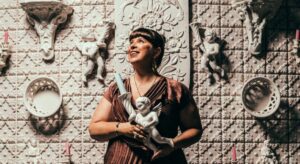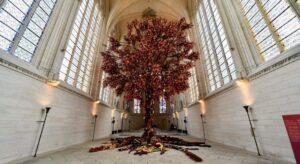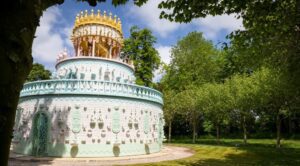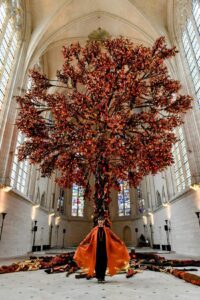This website uses cookies so that we can provide you with the best user experience possible. Cookie information is stored in your browser and performs functions such as recognising you when you return to our website and helping our team to understand which sections of the website you find most interesting and useful.
Material World: Artist Joana Vasconcelos’ monumental sculpture, Wedding Cake, is a tribute to women past and present
By Tessa Crowley | 3 July 2023 | Culture, Lifestyle
As Joana Vasconcelos launches Wedding Cake, her most ambitious installation to date, we speak to the conceptual artist about building monuments to the women who came before us

Joana Vasconcelos, image Arlindo Camacho
Portuguese artist Joana Vasconcelos is no stranger to big concepts, with her monumental installations dominating the grand halls of Waddesdon Manor, the Palace of Versailles, and the Guggenheim Bilbao, to name but a few. But the inspiration behind her extraordinary sculptures is rather more humble than their grand size might suggest.
Born in 1971, Joana began her career as a jeweller and artist before moving to sculptures created from textiles, ceramics and other household-inspired materials. In fact, it is the domestic space – and the craftsmanship that women of generations past used to express themselves – that informs her work, questioning our consumerism society and collective identity through the juxtaposition of domestic environment and public spaces.
Joana came to international renown at the 2005 Venice Biennale with her installation The Bride. In 2012, she was the youngest artist and first woman to have a solo exhibition at the Palace of Versailles, to a record-breaking 1.5million visitors. Her 2018 retrospective dominated the Guggenheim Bilbao. More recently, Joana’s 2023 Tree of Life – a 13m-tall handmade fabric depiction of Daphne’s final transformation – at Paris’s beautiful Sainte-Chapelle de Vincennes, made headlines for its delicate engineering and intricate detail, after her collaboration with fashion house Dior saw the creation of Valkyrie Miss Dior hit the Paris runway in March 2023.
Her latest project, Wedding Cake, is a 12m-tall ceramic sculptural pavilion that will dominate the grounds of Lord Jacob Rothschild’s Waddesdon Manor in Buckinghamshire from 15 June. Guests to the châteauesque manor can take a 45-minute sensory tour of Wedding Cake, before emerging in pairs at the very top.
“I want people to have three different approaches to it,” says Joana. “Looking from the outside, enjoying the surroundings from the different levels or balconies and rising to the top, finally completing the artwork with their presence. Above all, I always thought of it as a temple to love.”
Here, Joana tells us more about her dramatic artworks, down-to-earth inspiration, and how she is building monuments to the home.
Joana, how has your artistic style developed and evolved?
I studied jewellery and drawing. I learnt how to represent the world through my hands. I don’t think about [my work] as a style but, rather, I think about each new project individually. For me, the most important inspiration has always been the domestic environment. Every part of your house – kitchen, bathroom, bedroom – has a different identity, different objects and textiles, and I’ve been working from that concept for years.
I love opening the drawers of the past; in the past, all the labour that was done by our mothers, grandmothers, aunties. The crafts and objects that were made at home to decorate and protect your environment. We’re very blessed to be able to study, work, have our own personal expression, but that wasn’t true for our great-grandmothers. These women had to express themselves through these techniques and traditions, and I pay homage to them by representing them on this monumental scale.

Tree of Life, image Didier Plowy
Could you tell us more about your 2023 installation, Tree of Life?
Some projects are born in strange situations. I was invited to do a show in Villa Borghese exploring Gian Lorenzo Bernini’s sculpture Apollo and Daphne, where Daphne is being transformed into a laurel tree. My idea was to make her final transformation into the tree. I started the project – the engineering, embroidering leaves – but then it stalled due to Covid-19. During lockdown, our team was bored at home, so we continued [to create the tree].
Later, I was invited to Paris and we decided to develop the tree for Sainte-Chapelle – but I had to redesign it. Instead of being 5m tall, it became 13m; instead of a few leaves, we had 140,000. It was a much bigger [project], but still completely handmade, and valuing these traditional domestic crafts.
It’s based on the myth of Daphne and the essence of transformation – how important is mythology to your work?
I think all projects have three dimensions; physical, conceptual, and spiritual. Physical is the technical – it’s engineering, materials, technique – everything that connects you to earth. The conceptual dimension is the idea. This one comes from Daphne: she renounces her fate, so there’s an aspect of self-determination, of believing in yourself. Then the spiritual aspect – for Tree of Life, that came from the Sainte-Chappelle itself, where you have the apocalypse depicted on the windows, the end of the world, taking you to a spiritual dimension.

Wedding Cake, image Chris Lacey
Now you’re unveiling Wedding Cake, one of your most ambitious and interactive works to date. What can we expect?
It’s a gigantic ceramic piece. It’s a building; a temple. People can access the top floor [of the cake] in pairs, whether that’s two women, two men, people that don’t know each other, people that do. They might be people that are going to marry, are remarrying, renewing their vows. It’s a new aspect of tradition.
Marriage is one of the most important moments of most women’s lives. It’s when we transition from one family to another. There’s this sense of independence associated with marriage, and a lot of people still use the traditional symbols of this transition: the wedding ring represents the moment you promise to be married; the wedding dress represents the moment you are married; and then the wedding cake appears at the end of the party – now you go to start your new life.
You are also known for collaborating with the likes of Dior – how do fashion and art intersect for you?
I’ve been working with fashion designers for a while. Once, [fashion designer] Valentino came to the studio. He said, ‘Oh, you’re like an haute couture studio’. And it’s true; we work the same way. Every fashion designer that’s come here, from [Dior’s] Maria Grazia Chiuri to Karl Lagerfeld, has made the same comment. It’s easy for me to collaborate with them. I work with a lot of techniques close to the fashion world – in fact, I’m closer to fashion than I am to traditional sculpture.
Finally, tell us about your record-breaking exhibition at Versailles. What captured people’s imaginations?
Versailles is the paradigm of European culture, in the sense of those big châteaux and great houses of history. We have them in England, France, Belgium, Germany. We understand the traditional way of the grand house, of the table, of the domestic environment. So, unlike other artists might, I didn’t impose my work on Versailles, I produced my work for it. There was a relationship [between art and environment] that people understood as they arrived and explored. They felt the connection, the empathy. The textiles interconnected with each space. They felt at home – and that was what made it a success.
joanavasconcelos.com; waddesdon.org.uk

Tree of Life, image Didier Plowy







